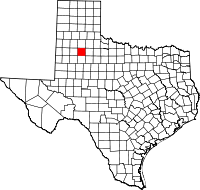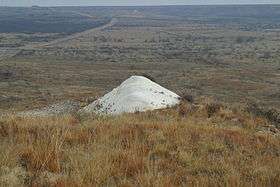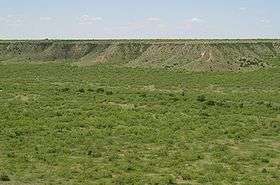Crosby County, Texas
| Crosby County, Texas | |
|---|---|
|
Crosby County Courthouse in Crosbyton | |
 Location in the U.S. state of Texas | |
 Texas's location in the U.S. | |
| Founded | 1886 |
| Seat | Crosbyton |
| Largest city | Crosbyton |
| Area | |
| • Total | 902 sq mi (2,336 km2) |
| • Land | 900 sq mi (2,331 km2) |
| • Water | 1.5 sq mi (4 km2), 0.2% |
| Population | |
| • (2010) | 6,059 |
| • Density | 6.7/sq mi (3/km²) |
| Congressional district | 19th |
| Time zone | Central: UTC-6/-5 |
| Website |
www |
Crosby County is a county located in the U.S. state of Texas. As of the 2010 census, its population was 6,059.[1] The county seat is Crosbyton.[2] The county was founded in 1876 and later organized in 1886.[3] Both the county and its seat are named for Stephen Crosby, a land commissioner in Texas.
Crosby County, along with Lubbock County, and Lynn County, is part of the Lubbock Metropolitan Statistical Area (MSA). The Lubbock MSA and Levelland Micropolitan Statistical Area (µSA), encompassing only Hockley County, form the larger Lubbock–Levelland Combined Statistical Area (CSA).
Until the passage of a referendum to permit liquor sales, held on May 11, 2013, Crosby County had been one of nineteen remaining prohibition or entirely dry counties within Texas.[4] That same day voters in Denver City and Yoakum County also approved separate referenda to permit liquor sales. The number of prohibition counties in Texas has hence dropped to seventeen.[5] Part of the large Matador Ranch of West Texas extends into the county.[6] Republican Drew Springer, Jr., a businessman from Muenster in Cooke County, has since January 2013 represented Crosby County in the Texas House of Representatives.[7]
History
- 11000 b.c. Paleo-Indians first inhabitants. Archeological artifacts indicate Hunter-gatherers who hunted the Mammoth, Mastodon, Saber-Toothed Tiger, and Giant Ground Sloth. Later Native American inhabitants include the Comanche.[8]
- 1871 Ranald S. Mackenzie fights Quanah Parker and other Comanches at the Battle of Blanco Canyon. The campaign establishes the Mackenzie Trail used by the first settlers in Crosby County in the late 1870s.[9]
- 1876 The Texas legislature forms Crosby County from Young and Bexar districts.[8]
- 1878 Bavaria-born Heinrich Schmidtt, aka Henry “Hank” Clay Smith, and his wife Elizabeth Boyle and their six children, become the first permanent settlers in the area, where Hank is active in the county’s organization.[10][11][12]
- 1879 Confederate veteran Paris Cox first visits the Caprock Escarpment of the Llano Estacado with a group of buffalo hunters.[13]
- 1886 Estacado is named the county seat.[14]
- 1900 The beef industry thrives, supporting a count of 30,618 head.[8]
- 1908 The Bar-N-Bar Ranch begins selling acreage to farmers.[8]
- 1910 Crosbyton becomes the new county seat.[15]
- 1920 Some 45,400 acres (184 km2) in the county are planted in cotton. 15.000 apple and peach trees grow in the county.[8]
- 1929 Farmers own 83,000 chickens, and sell 395,000 dozen eggs.[8]
- 1941 The first soil-conservation district in the county is formed.[8]
- 1955 Oil is discovered in the county.[8]
Geography
According to the U.S. Census Bureau, the county has a total area of 902 square miles (2,340 km2), of which 900 square miles (2,300 km2) is land and 1.5 square miles (3.9 km2) (0.2%) is water.[16]
Major highways
Adjacent counties
- Floyd County (north)
- Dickens County (east)
- Garza County (south)
- Lubbock County (west)
Geographic features
Demographics
| Historical population | |||
|---|---|---|---|
| Census | Pop. | %± | |
| 1880 | 82 | — | |
| 1890 | 346 | 322.0% | |
| 1900 | 788 | 127.7% | |
| 1910 | 1,765 | 124.0% | |
| 1920 | 6,084 | 244.7% | |
| 1930 | 11,023 | 81.2% | |
| 1940 | 10,046 | −8.9% | |
| 1950 | 9,582 | −4.6% | |
| 1960 | 10,347 | 8.0% | |
| 1970 | 9,085 | −12.2% | |
| 1980 | 8,859 | −2.5% | |
| 1990 | 7,304 | −17.6% | |
| 2000 | 7,072 | −3.2% | |
| 2010 | 6,059 | −14.3% | |
| Est. 2015 | 5,977 | [17] | −1.4% |
| U.S. Decennial Census[18] 1850–2010[19] 2010–2014[1] | |||
As of the census[20] of 2000, there were 7,072 people, 2,512 households, and 1,866 families residing in the county. The population density was 8 people per square mile (3/km²). There were 3,202 housing units at an average density of 4 per square mile (1/km²). The racial makeup of the county was 63.77% White, 3.89% Black or African American, 0.54% Native American, 0.03% Asian, 0.07% Pacific Islander, 29.89% from other races, and 1.81% from two or more races. 48.93% of the population were Hispanic or Latino of any race.
There were 2,512 households out of which 35.6% had children under the age of 18 living with them, 59.0% were married couples living together, 11.4% had a female householder with no husband present, and 25.7% were non-families. 23.8% of all households were made up of individuals and 13.4% had someone living alone who was 65 years of age or older. The average household size was 2.78 and the average family size was 3.30.
In the county, the population was spread out with 30.7% under the age of 18, 8.5% from 18 to 24, 24.0% from 25 to 44, 21.1% from 45 to 64, and 15.6% who were 65 years of age or older. The median age was 34 years. For every 100 females there were 91.1 males. For every 100 females age 18 and over, there were 87.2 males.
The median income for a household in the county was $25,769, and the median income for a family was $29,891. Males had a median income of $23,775 versus $17,229 for females. The per capita income for the county was $14,445. About 22.6% of families and 28.1% of the population were below the poverty line, including 36.6% of those under age 18 and 22.7% of those age 65 or over.
Communities
Cities
Unincorporated communities
Ghost towns
- Canyon Valley
- Estacado (partly in Lubbock County)
Gallery
-

Caprock Escarpment south of Ralls
See also
References
- 1 2 "State & County QuickFacts". United States Census Bureau. Retrieved December 9, 2013.
- ↑ "Find a County". National Association of Counties. Archived from the original on May 31, 2011. Retrieved 2011-06-07.
- ↑ "Texas: Individual County Chronologies". Texas Atlas of Historical County Boundaries. The Newberry Library. 2008. Retrieved May 21, 2015.
- ↑ "Archived copy". Archived from the original on May 16, 2014. Retrieved May 3, 2014.
- ↑ "Voters approve sales of alcohol in three elections". Lubbock Avalanche-Journal, May 12, 2013. Retrieved May 13, 2013.
- ↑ "Alyssa Dizon, "Cattle raisers honor Matador Ranch with rangeland management award"". Lubbock Avalanche-Journal, April 4, 2011. Retrieved April 29, 2011.
- ↑ "State Rep. Springer announces district tour July 30". Lubbock Avalanche-Journal, July 16, 2013. Retrieved July 18, 2013.
- 1 2 3 4 5 6 7 8 Leffler, John. "Crosby County, Texas". Handbook of Texas Online. Texas State Historical Association. Retrieved December 16, 2010.
- ↑ Gwynne, S. C. (2010). Empire of the Summer Moon: Quanah Parker and the Rise and Fall of the Comanches, the Most Powerful Indian Tribe in American History. Scribner. pp. 10, 11. ISBN 978-1-4165-9105-4.
- ↑ Rodenberger, Lou Halsell; Butler, Laura Payne; Kolosoy, Jacqueline (2005). "Elizabeth Boyle (Aunt Hank) Smith". Writing on the Wind: An Anthology Of West Texas Women Writers. Texas Tech University Press. p. 174. ISBN 978-0-89672-548-5.
- ↑ "Smith, Henry Clay (1836–1912) – Crosbyton, Crosby County, Texas". Texas Historical Markers. William Nienke, Sam Morrow. Retrieved December 16, 2010.
- ↑ Pearce, William M. "Henry Clay Smith". Handbook of Texas Online. Texas State Historical Association. Retrieved December 16, 2010.
- ↑ Lively, Jeanne F. "Paris Cox". Handbook of Texas Online. Texas State Historical Association. Retrieved December 16, 2010.
- ↑ "Estacado, Texas". Texas Escapes. Texas Escapes – Blueprints For Travel, LLC. Retrieved December 16, 2010.
- ↑ "Crosbyton, Texas". Texas Escapes. Texas Escapes – Blueprints For Travel, LLC. Retrieved December 16, 2010.
- ↑ "2010 Census Gazetteer Files". United States Census Bureau. August 22, 2012. Retrieved April 21, 2015.
- ↑ "County Totals Dataset: Population, Population Change and Estimated Components of Population Change: April 1, 2010 to July 1, 2015". Retrieved July 2, 2016.
- ↑ "U.S. Decennial Census". United States Census Bureau. Archived from the original on May 11, 2015. Retrieved April 21, 2015.
- ↑ "Texas Almanac: Population History of Counties from 1850–2010" (PDF). Texas Almanac. Retrieved April 21, 2015.
- ↑ "American FactFinder". United States Census Bureau. Archived from the original on September 11, 2013. Retrieved 2011-05-14.
External links
- Panhandle-Plains Historical Museum
- Crosby County government’s website
- Crosby County, Texas from the Handbook of Texas Online
- Crosby County Profile from the Texas Association of Counties
- Photos of the Llano Estacado
 |
Floyd County |  | ||
| Lubbock County | |
Dickens County | ||
| ||||
| | ||||
| Garza County |
Coordinates: 33°37′N 101°18′W / 33.61°N 101.30°W



